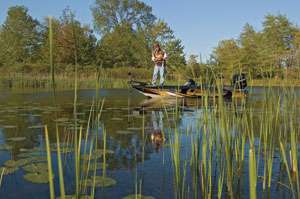
Toad fishing is for most fishermen a no-brainer. Cast this bait with a stiff rod and braided line, hold the rod up and crank fast enough to make the legs sputter on the surface. That might be good enough for weekend warriors, but toad fishing gets more involved when you make your living casting for cash, according to Frank Scalish of Cleveland, Ohio.
Months before the Zoom Horny Toad was introduced in 2005, Scalish finagled some prototypes of the bait from a fellow bass pro. During a fall tournament on New York's Hudson River, he slammed smallmouth bass by swimming the toad over lily pads and shallow grass. After that impressive debut, Scalish figured he had toad fishing down. He figured wrong.
Later, at Florida's Harris Chain, bass after bass exploded on the toad as Scalish retrieved it over small openings behind a wall of bulrushes. "They were blowing the toad out of the water, but I couldn't get a hook in them," Scalish said. "That's when I knew I had toad issues."
He still had toad issues on the first day of a Bassmaster Elite Series event at the Potomac River in August 2006. Largemouth erupted on the toad as Scalish retrieved it over clumpy milfoil beds. Sadly, he missed most of them and limped to the scales with a featherweight sack.
That evening, Scalish held an intervention with his toad. He pegged a 1/16-ounce bullet sinker to the nose of the bait with a bobber stopper. This, he hoped, would hold the toad upright and slightly deeper in the water so the bass could get a better grip. The next day, Scalish's strike-to-catch ratio improved dramatically. He sacked 17 pounds, 11 ounces, the heaviest limit of the tournament.
The pegged sinker modification pulled Scalish from oblivion to finish in 33rd place. However, even with the pegged sinker, several bass had missed the toad, particularly where waves were rolling into the grass. "I needed to do something that would help bass home in on the toad in rough water," Scalish said.
He hit on an idea while driving back to Ohio after the tournament. When Scalish pulled into his driveway, he dashed straight to his basement workbench to make a modification that proved deadly.
It is essentially a 1-inch leader of .030-inch stainless steel wire that has a closed loop in each end. (You can snip wire from an old spinnerbait for this.) One end of the loop runs through the eye of Zoom's 5/0 Horny Toad Hook.
You tie your line to the other loop. Scalish squeezes the lead loop with pliers to make it oval. This helps it shed grass. Between the loops is a small metal bead, followed by a propeller blade from a Cordell Crazy Shad, another metal bead and, finally, a black nickel nose cone used with steelhead flies.
The nose cone, available at fly fishing outlets, is crucial because it prevents grass from fouling the prop blade. "The prop gives the toad a completely different sound," Scalish explained. "It's a whoosh! whoosh!, not a steady sputter like a toad's legs or a buzzbait blade."
The prop toad's initial test run happened when Scalish practiced for a fall tournament at Kentucky Lake. He fished with a friend, and they switched off between a Horny Toads rigged with and without a prop blade.
They caught nearly 40 bass, and the prop toad outperformed the other 3 to 1. Scalish's prop toad continues to be one of his go-to baits. He said he has fished behind anglers that were getting few bites on regular toads only to slam bass on his modified toad.
However, Scalish reserves the prop toad for choppy water. In slick conditions, he fares better with a toad rigged with a 1/32- or 1/16-ounce pegged sinker. Should a bass miss the toad, Scalish kills the bait and lets the sinker pull it toward the bottom, which often triggers a second strike. Water conditions also tell Scalish which toad to use.
He's tried most of the myriad toads now being offered and relies mainly on the Horny Toad and Stanley's Ribbit. The Horny Toad, with its subtle, curl-tail legs, does the job in flat water. The Ribbit's nosier, booted legs call up more bass when there's a chop.
Stanley's Double-Take Hooks
Stanley Jigs claims you'll hook more bass with their new Ribbit Double-Take toad hook. It features two side-by-side hooks with a screw-in keeper.
The extra long hooks are designed to penetrate the legs of Stanley's Ribbit, and they work well with many other toads. Choose between a Double-Take hook that has no weight and one that has a 1/8-ounce Wedgehead weight molded to the tip.
The weighted hook holds the bait lower in the water and makes it plow through grass.
More toad applications
Scalish has had good success fishing a toad on a Carolina rig. He also knows pros who catch bass swimming jigs dressed with toads.
Although Scalish has experimented with the jig-swimming presentation, he said he doesn't believe the toad outperforms plastic chunks and craws.

